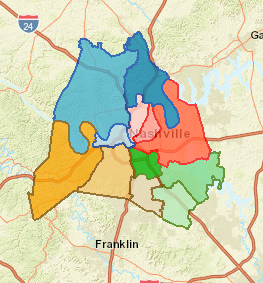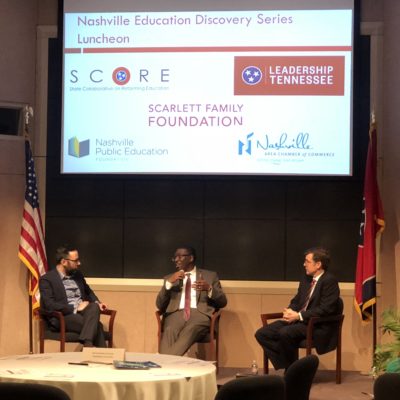
A City on the Move. Students Left Behind.
Our city is growing at a breakneck pace. Consider the constant headlines on new industry setting up shop in Nashville: Amazon, E&Y, Philips, and Alliance Bernstein are committed. Oracle is in talks. And we can’t ignore the boost in tourism brought by the NFL Draft, the Predators reaching for the Stanley Cup, and a continual stream of talented musicians showcasing their songs. Music City is booming. As we stare this new economic landscape in the face, we must acknowledge that our growth is outpacing our ability to provide homegrown talent to the local workforce. It has never been more important to focus on Nashville’s K-12 public education system.
From a district-level perspective, we can see immediately that something is wrong. Three out of four of third graders aren’t reading on grade level. Almost 20% of students are chronically absent from school (missing 10% or 18 school days). And three out of four MNPS high school students did not score a 21 or higher on the ACT, a widely accepted indicator of college and career readiness. Our public education system, the foundation of our community, is crumbling. The benefits of the economic boom in Nashville are not extending to all residents — particularly our MNPS students.
In order to tell the whole story, we realized we needed to zoom in, to see in greater detail how specific schools and neighborhoods are performing— to see how Hillsboro compares to Antioch, and how Whites Creek stacks up to McGavock.
The critical question is: are students ready for life when they graduate from high school?
One way to tell is to look at each “cluster” of schools.

MNPS is divided into 12 clusters, or zones, with all elementary and middle schools feeding into one high school per zone. Students are zoned to their cluster of schools according to their address, and will follow a zoned pathway from elementary to middle to high school. Families in Nashville do have choice, though, meaning they can opt to apply to a magnet school, non-zoned school or public charter school even if the school is not in their assigned zone.
There is so much data to explore; and that is why this is only the first in a series of blogs that will unpack the information found in our MNPS Cluster Profiles. In future pieces, we will be looking closely at the readiness of high school graduates, district enrollment trends, and teacher retention, among other topics.
Lowest-Performing Schools concentrated in three neighborhoods
The number of priority schools (schools ranked in the bottom 5% statewide) in Nashville has increased in the last three years— to 21 total. As we look at the location of these schools, we see that they are largely concentrated in three neighborhood zones: Whites Creek, Maplewood and Hunters Lane.
Students in these three zones are likely to attend not just one, but two or even three priority schools during their K-12 years. If dramatic improvement is not made, a majority of students in the Whites Creek cluster will attend a school in the bottom five% statewide for every year of their education.
Great schools, but not in every neighborhood
Similarly, our city’s highest achieving schools are concentrated in just a few neighborhoods. Hillsboro, Hillwood and Overton zones have the highest performing high, middle and elementary schools. Many of the traditional schools that meet or exceed the state averages for English and Math achievement are located within these three neighborhoods.
Another significant observation: of our 22 Reward schools (schools recognized by the state for making gains in student growth and achievement), only nine of them are actually within the traditional cluster pathways— one, LEAD Cameron Middle, is a charter school. Six of them are non-zoned MNPS schools and have additional admission requirements (such as academic magnets). Another seven are non-zoned charter schools. These public charter schools practice open enrollment, allowing for any Nashville student to enroll regardless of home address.
As we begin to piece these data together, we quickly realize that access to the best schools is limited. Unless families choose to attend a high-performing charter school, students either need to live in the “right” zone, or gain acceptance to an academic magnet school.
Enrollment drain in every neighborhood
Every single MNPS cluster experiences a large student enrollment drop-off from elementary to middle school. The size of the drops ranges widely, from 40% at McGavock and Hunters Lane to 59% at Maplewood, but the trend is consistent. MNPS middle schools have far fewer students enrolled than do their feeder elementary schools.
It is an unfortunate reality that Nashville families are often forced to look outside of their neighborhood schools in order to provide their children a high-quality education. But the numbers prove that many parents are making that choice.
Nashville graduates not ready
If we track those students who do follow their zoned school pathway from the start of their K-12 career to the finish, we see the number of students classified as “On Track” or “Mastered” in English and Math proficiency slide downward from elementary school to middle school, and from middle to high school.
- Not one high school has an average ACT score of 21 (the minimum score considered college or career ready)
- Eight of the twelve high schools have average scores below 18, with five scoring 16 or below.
- At eight high schools, fewer than one in ten students are “On Track” or “Mastered” for both English and Math.
Yet MNPS graduation rates hold steady at about 80%.
Year after year, MNPS bestows upon our high school seniors a diploma, a mutually understood signal that these students are ready to forge ahead to college or the workforce. But many of them are not actually prepared for the next step.
The consequence of regularly passing students who are not grade-level proficient from one level to the next is clear: our graduates fail to meet the demands of college or the workforce. We see this plainly in college completion rates. According to a recent report by the Nashville Public Education Fund, only one in four MNPS graduates actually completes a degree after leaving the district.
A crisis in chronic absenteeism
In addition to proficiency deficits, Nashville’s high schools are also facing a chronic absenteeism crisis. A third, and in some cases more, of MNPS high school students are missing at least 18 days of school per year.
- At Stratford STEM, almost half of students miss 18 or more days of school.
- Maplewood and Whites Creek have absentee levels above 40%.
- Four more schools are at or above 30% (Antioch, Pearl Cohn, Hunters Lane, & Glencliff).
These data help to put our student achievement shortfall in context; if students are not in the classroom, our educators cannot teach them.
Bright spots of strong success
Although there are shortcomings that must be acknowledged, MNPS schools also give us reasons to be encouraged.
Each of the following schools operates within the most challenging MNPS zones— and has demonstrated remarkable achievement and growth.
- Shwab Elementary (Maplewood) is a reward school for 2018.
- Joelton (Whites Creek) shows student achievement at 40%, four times that of neighboring schools.
- Dan Mills (Stratford) presents low chronic absenteeism numbers and student achievement over 50%.
- LEAD Cameron was recognized as a Reward school for the second year in a row. This school serves as the zoned middle school option for students in the Glencliff cluster.
It is true that data only tell one side of the story, and that the context for these numbers can vary widely from school to school, classroom to classroom. But by diving into these numbers, we are able to illuminate the parts of our public school system that are working well, and to put a critical spotlight on the areas that desperately need improvement. With this goal in mind, we will continue to highlight our top data-driven takeaways in a series of blog posts to be released over the coming weeks.
We hope to present school data in a way that feels accessible to all members of our community, from parents to principals, employees to CEOs. We believe that when all Nashvillians can have an informed conversation about our public education system, innovation and improvements will follow. Together, we can take steps to ensure that every child in Nashville receives a high-quality public education and is prepared for success after graduation.
Please check back for more on our blog series on the MNPS Cluster Profiles.



